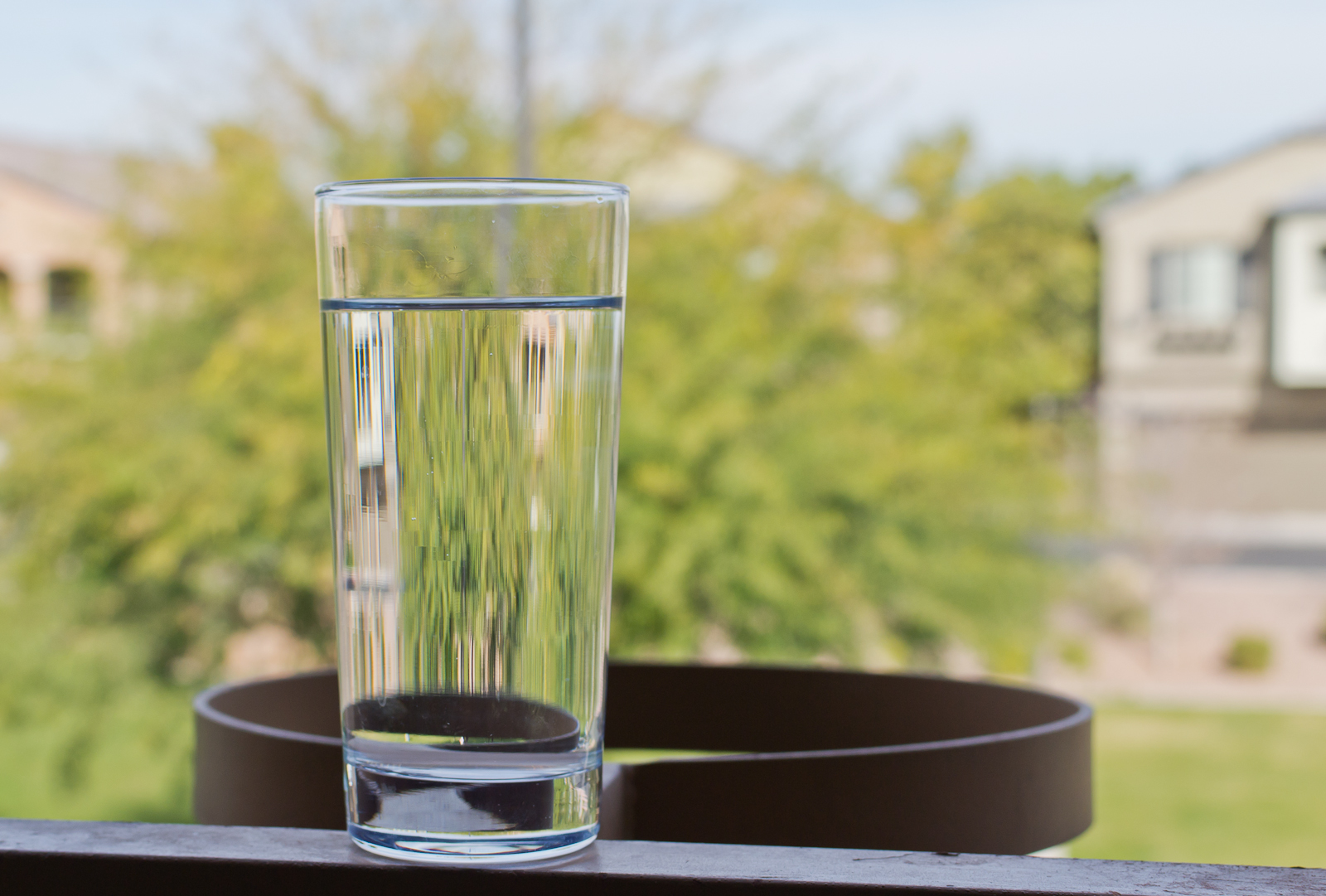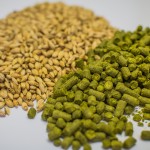Water Chemistry – How to Build Your Water

I’m sure you’ve heard it before: Beer is over 90% water. That little adage would lead you to believe that quality water is the most important factor in good beer. I won’t go that far, but quality water does help. Aside from temperature controlled fermentations, starting with reverse osmosis water and building back minerals has made the biggest difference in the quality and consistency of my brews. The best part is, it’s really not that difficult or confusing. It’s easier for me to do this in a Q&A format, so i’ll be asking my self questions =)
What the hell is reverse osmosis water?
Reverse Osmosis is a selective filtration process that greatly reduces the ion levels in the source water. It also removes many of the nasties found in water that you wouldn’t want to drink. You’re probably more familiar with R/O water than you think. The water machines that dispense water in front of grocery stores for 25c per gallon, those are R/O machines.
Ok, but why not use tap water?
Like many big urban cities, in Metro-Phoenix, our water is awful for brewing. It’s some of the hardest water you’ll find, it’s loaded with chlorine, and rather high in sodium too. If you filter out the chlorine, it might be decent water for hoppy or roasty beers, but the other issue is the mineral levels vary greatly depending on the water’s source. So you’re rolling the dice on pretty much every batch. Thankfully my brew-buddy Greg has a R/O system installed under his sink, but even for brewers that don’t, you can buy R/O water from those machines in front of the grocery store. Just fill up a fermenter or two.
So what makes R/O water better?
I won’t get into too many of the technicalities of reverse osmosis, but there are a few important things to know. First is that using R/O water isn’t going to win you the ‘Greenest Brewer in the World’ award. Typical commercial R/O units waste approx. an equal amount of water than what is recovered. So your 10 gallons of water took 20 gallons to make. Household under-the-sink units are worse, usually wasting water at an 8 to 1 ratio. The next important thing to know is that R/O reduces ion levels in water by roughly 9 to 1. So if your water had 300ppm of calcium, after R/O it would have ~ 33ppm; it’s not quite as pure as distillation. Because of this, it’s important to know the mineral content of the base water, since it will affect how you build up water for styles that require very soft water (e.g. Czech Pils).
Huh?
Basically, R/O strips all the minerals in your water down to very low numbers we can consider a ‘baseline’. From that baseline, we can easily add back what we need to make our water ideal for brewing.
That makes sense, but why not just use straight R/O water for brewing?
Well if you’re an extract brewer you certainly can, but you’ll most likely find that your beers are missing something that made the flavors ‘pop’. If you’re an all-grain brewer, you’ll have the same issue, but you’ll also suffer some efficiency issues, as your mash pH won’t be in the ideal range. As it turns out, we need the minerals that are typically found in our tap water. Starting with R/O water gives us the ability to control the concentration of those minerals.
So how do I start building my water, I’ve seen brewing water calculators online, they look very complicated?
Assuming your source water isn’t off-the-charts hard, post-RO, it’ll be relatively devoid of minerals (remember 9 to 1 reduction). For the basic style of beer, I simply:
-Add 1tsp of calcium chloride per 5 gallons of water
-Add 2% acidulated malt to my grain bill (typically between 3 and 5 ounces for a 5 gallon batch.
That’s it.
But don’t different beer styles require different water?
Yes, that’s correct.
Roasty beers (stouts, porters), I skip the acidulated malt.
Hoppy syles (APA, IPA, IIPA), I also add 1tsp of gypsum
Soft water beers (Czech Pils), I cut the calcium chloride down to 1/2tsp
British styles, I double the calcum chloride, and add 1tsp of gypsum.
Those are what work well for me. You may find you need to tweak those numbers some to find what works best for you.
Aren’t there other minerals that brewers add like chalk, epsom salts, and baking soda?
Yes.
And……?
I don’t find I need them. Acid malt, calcium chloride, and gypsum are all I ever use, and I’ve made plenty of great beers.
Won’t acid malt make my beer taste sour?
Good question. Beers will taste better when their pH is in a certain range. Without acid malt, a mash starting from R/O water will have a pH that’s too high, efficiency will suffer, and the beer may taste a little flat. Adding 2-3% acid malt will help lower the mash pH by .2-.3, and I find that it helps accentuate flavors. If you use too much acid malt(5-6%) you will start to taste the acidity, so keep it under 4%.
Lastly I need to give credit and many thanks to ajdelange on Homebrewtalk. Much of this information is from his excellent water chemistry primer.Over the past 18 months, I’ve made some great beer following his techniques for building water, and I’ve very thankful for the good advice!




Good post, really to the point. I don't use R.O water myself but I have figured out how to work with what I have. Im thinking of adding some R.O water to my summer lagers to soften them up.
Hey, this is awesome…question.
When you make you’re “adjustments” per beer style…that’s in “per 5 gallons” increments…so add the gypsum per 5 gallons or increase the Calcium Chloride per 5 gallons the amounts discussed above…right?
Thanks! I was trying to keep it very centric to what I do, which is starting with RO and building from there. There's definitely more than one way to skin a cat.
Thank you very much for the explanations! I have been all grain brewing for a few months and want to start building my own water. So, is this to treat all water during the brew day or just the water used in the mash and sparge?
Thanks again!
Mash water and sparge water are the only times I add water during the brew process, so I would say: Yes.
If you're adding water at another time during the brew day, I would say it would depend on how much. If you add .5 gallon, I wouldn't worry about salts, as you're not going to dilute your batch much. If you're adding 1-2 gallons, then ya, definitely add the appropriate salts.
Hi I'm a beginning brewer in Mesa with a similar taste in beer. I seem to have more time to read than brew so far and your blog has been pretty helpful/interesting.
1. When you add gypsum/calcium chloride, do you do it pre mash or during boil? Are these additions raising or lowering pH?
2. I don't see acidulated malt appearing in any of your recipes. Do you simply add 2% on top of the existing grain bill for everything you brew and then ignore whatever small changes this makes to OG, FG, etc?
3. Have you ever measured your mash pH to confirm that the calculated malt is putting you in the right range?
Thanks a lot!
Jake
Great to see someone from the East Valley.
1. I treat the water as I used it. So I'll mix it in with the strike water, or in with the grains. Then again, I'll mix the salts in with the sparge water. They dissolve very quickly in hot water.
2. Ya, I leave it off the recipes because it's 2% in every beer. So literally every beer, 2% acid malt, unless it's a stout or porter. (Dark roasted malts will lower the pH).
3. I haven't, but I probably should. The beers turn out well, so I haven't questioned it.
Hey,
I'm gonna try my first brew session with RO tommorrow. I am getting my RO water from my local Whole Foods market. Would you know if their RO be more devoid of mineral and need extra salts than the typical home unit, like the one you have?
Thanks for the write up.
Cheers!
Joel
I'd guess it's pretty similar. Most commercial units are going to operate with a 90-95% rejection rate.
Play around with it though. My base water profile is still moderately soft, so you could easily double my mineral amounts, and still have a fine beer. There's little risk, and you'll find what you like.
Hey there. I'm in Chandler, AZ and will soon be using my new under sink RO system. Do you add anything like the 5.2 ph stabilizer in addition to what you mention above? You didn't mention it so I'm pretty sure that's a no, but I've heard so many people say it's a must that I wanted to confirm.
Nope, no 5.2. I love 5-Star products, but I personally think 5.2 is snake oil.
The one downside to the under-the-sink units is they don't store much water. I have to collect my brewing water over the course of a day or two before I plan to brew.
As for minerals, I buy everything over at Brew Your Own Brew on Baseline and Mesa (Great guys). Acid Malt, Calcium Chloride and Gypsum are really all you need, and they have them for cheap.
Sweet, thanks for the reply. That's the shop I go to as well. I used Calcium Chloride and Gypsum on my last batch Sunday but no Acid Malt because I had no on hand (and I skipped the 5.2 this time). Target OG was close to the recipe I had. I'll try the Acid Malt next time.
Took your advice and found some primo water at wally world that claims to be RO. I went ahead and measured the ph pre salt additions and it was around 6. I was brewing an american wheat so i just used the CC and 2% Acidulated (Weyermann) Malt. I checked the ph 10 minutes after mashing in and it was very low…maybe as low at 4.6. i didn't have anything to raise mash ph so just stuck it out. All my temps were good for a single infusion mash. My OG ended up very low around 1.032 when it should have been 15 points higher based on my grain bill. I wounder if that low mash ph had something to do with it or since i was using wheat i should have done a decoction mash. I would be interested in the ph of your RO water prior any calcium chloride additions if possible.
Wow, that is a very low pH. I'd definitely recommend leaving out the acid malt next time, as you clearly don't need it.
As for the low gravity, it could be a few things. Wheat generally has to be crushed tighter to get good efficiency from (in my experience), and the pH could definitely have affected your efficiency.
I'll see if I can check my water for you.
Thx
Thanks for the water help. Question, you say add X amount per 5 gallons of water. Is this batch size or water total? I may use close to 10 gallons of water to make a 5 gallon batch (grain absorption and boil off). So if i'm making 5 gallon batch of IPA and using 10 gallons to mash/sparge with, i'm going to treat the 10 gallons with 2 tsp calcium chloride and 2 tsp gypsum. Along with 2% acid malt to my grain bill. Or just 1 tsp each CC and Gypsum for the 5 gallon batch?
Water total. So the usual 5gal batch for me takes like 8-9gal of water, so I use roughly 2x those number for the entire batch. 3.5-4x for a 10 gallon batch.
Really appreciate your help with the water profile on your farmhouse saison…just made something similar and it turned out great! Can you also tell me what water additions / profile you recommend for a dark hoppy beer (similar to your Black West Coast IPA)?
Thanks again, have learned a bunch from your blog!
I'm thinking treat the mash like a stout / porter, then add gypsum to the boil for hop bitterness?
That's what I would do, treat it like a stout, but add a bit more gypsum. Maybe an extra 1/2tsp.
Awesome I really appreciate it! Congratulations on the wedding!
What kind of RO system do you and Greg use? The 50 GPD systems that run a few hundred bucks don't seem like they product enough water to collect 8 or gallons of water in a short time.
The typical under the sink GE RO systems. Ya, they really don't generate enough water quickly. Greg installed a second water bladder at his new place. I've resorted to collecting water a few days in advance. It's not ideal, but it works.
when do you add these additions? at dough in, at sparge or at boil? or do you do half at dough in and half during sparge? thanks in advance!
This comment has been removed by the author.
As you said, RO water has many benefits. And we need to choose a reliable RO system, and this link may help: http://top5best.org/top-5-best-reverse-osmosis-systems-buying-tips-guides/
This comment has been removed by the author.
Thx for the info, btw what's about imperial stouts/porters
R/O water filter system is good. I used 1 years ago.
Awesome article. I have been looking for a easy to understand article on water chemistry. Thanks!!
Are you still following the principles outlines above?
What do you think about using distilled water? Could I follow the same additions that you use with RO water with similar results?
Ya, pretty much the exact same procedures. Distilled water is just a little cleaner than RO.
First off thank you very much for this! I have a question about what you would do with wheats and Browns? Treat them like a standard light or pale with acid malt and cal chlor? The wheats I’m doing this summer are hoppier American style wheats so I’ll maybe add a little gypsum, the Browns I’ve been looking at don’t have much for chocolate or roast malt.. Just wondering what you would do for your $.02
Thanks for an easy to follow article for us just starting to adjust water…
For the acidulated malt, when you are talking percentages.. is that just their percentage in the grain bill?
Also how do you adjust for German style weiss beers?
Thanks for everything. I’ve been checking out several of your other posts this afternoon. Good stuff!
I’ve been using an RO/well water mix since starting my home brewing over 20 years ago. I just happened to have an RO filter for my tropical fish breeding operation and thought the same science could apply to both. Guess I just got lucky and started off making some pretty awesome tasting beer without really knowing why. I used the RO water then added the necessary ingredients to get the right PH and minerals for African Lake fish and it dawned on me that I could do the same with beer to get the best tasting water, figured it would make the beer better and it did. From what I’ve read above and other blogs, I’ve still got a lot to learn but feel satisfied that I was on the right track! One more thought… Ever think of water as a sponge? I always considered RO water like an empty sponge. Every time I use RO water for things like coffee or tea, it seems to bring more out of the grounds/leaves and the sugar I put in it dissolves much easier and doesn’t complete for flavor already present in the water. I considered this would apply the same if I start my cook with pure RO then add in my mineral water afterwards. Just my theory, but the RO water seems to dissolve the sugars faster and pull out more of the flavor from the grains/hops before adding in the mineral water.
When you say you add 1 tsp of Gypsum for Hoppy styles is that per 5 gal. of water?
This article is far too general. Get a water report from your municipality as it has all the key elements that you need, Calcium (Ca) , Magnesium (Mg) , Sodium (Na) , Chloride (Cl) , Sulphate (So4) and Water hardness usually measured as Calcium carbonate (CaCO3). Enter the details into software such as ‘brew n water’ and you will get a very accurate depiction of the makeup of your water and EXACTLY the elements that you need to reduce or add.
Cool, except the report for Monday and Tuesday and Thursday etc. are different and dependent on where you are on the distribution it will be different. Also most city water systems try to maintain good quality water by blending seasonally from ground sources and well sources and the treatment varies dependent on the need. R O water as a base and adding the minerals is a much surer way. Sometimes I add one cup tap water to the R O water and call it good since the tap water is high in calcium. But!!!